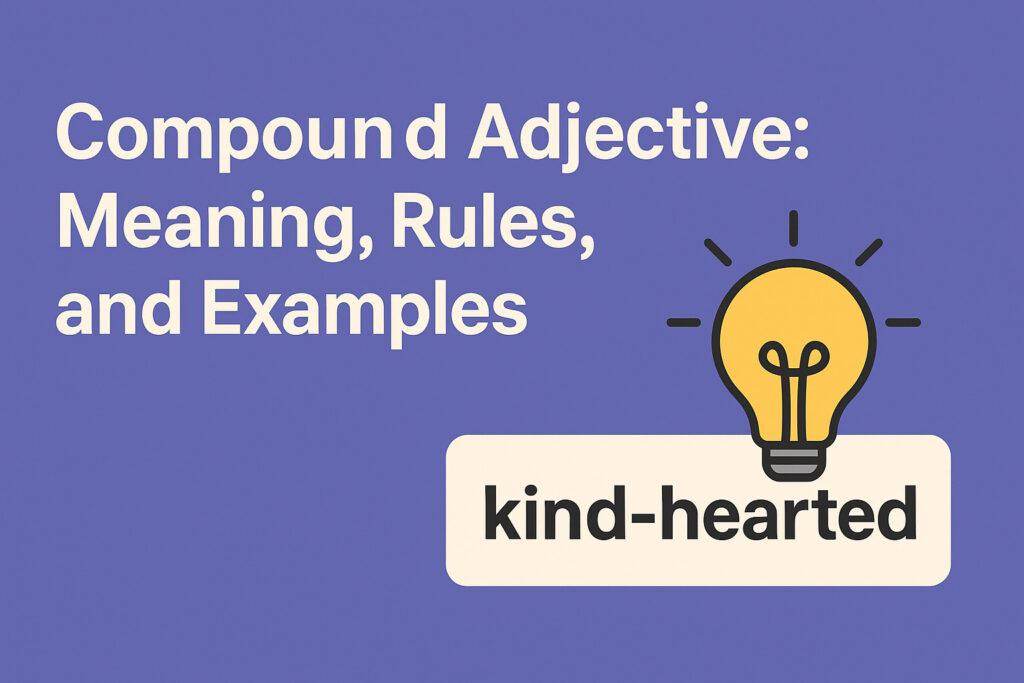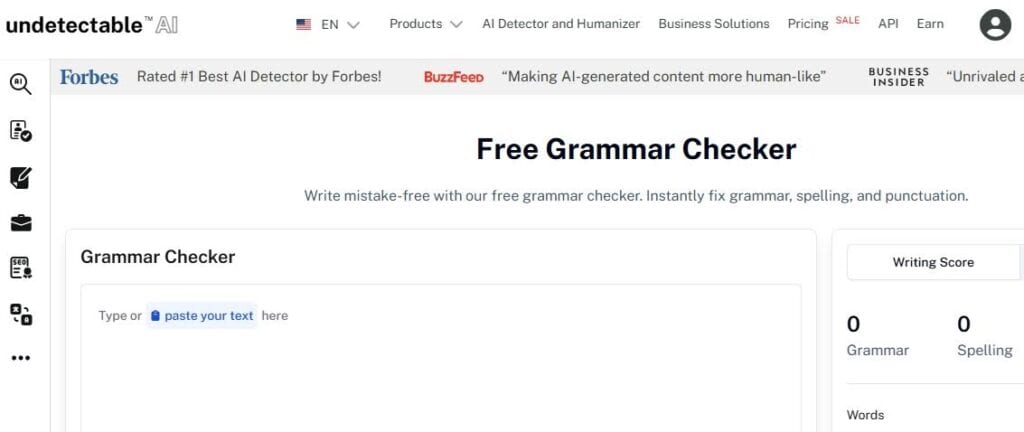Sometimes, a standard adjective isn’t enough to describe something in a more specific or nuanced way.
In those situations, you have to combine multiple words to convey the intended meaning.
That combination of words to describe something is called a compound adjective.
But what exactly are they by definition, and how do you form them? You’ll learn it all in this detailed guide.
Let’s get into the details.
Key Takeaways
- A compound adjective is made up of two or more words that work together to describe a noun.
- A compound adjective isn’t the same as coordinate adjectives.
- There are multiple situations when you must hyphenate a compound adjective and when you shouldn’t.
- There are several patterns of forming compound adjectives.
What Is a Compound Adjective?

You’ve probably tried using the adjective “state-of-the-art” in a sentence like this before:
“Our company just opened a state of the art facility downtown.”
But your text editor immediately underlines it as if it caught a typo and insists that you add hyphens to it.


Never Worry About AI Detecting Your Texts Again. Undetectable AI Can Help You:
- Make your AI assisted writing appear human-like.
- Bypass all major AI detection tools with just one click.
- Use AI safely and confidently in school and work.
Or maybe your teacher circled it in red ink and wrote “hyphenate this” in the margin. If not with this specific adjective, you might have faced this with some other adjective.
What you’re dealing with there is a compound adjective.
A compound adjective is made up of two or more words that work together as a single unit to describe something more precisely than a regular adjective might on its own.
The most common compound adjective structure you’ll see is two words joined by a hyphen when placed before a noun.
However, hyphenation isn’t always required. Whether or not to hyphenate depends on where the adjective lands in the sentence and how clear the meaning is without the hyphen.
We’ll get into those rules in a bit.
Also, there’s no real limit to how many words can come together to form a compound adjective.
Here are some compound adjective examples to show how far they can stretch:
- Two-word: low-budget film
- Three-word: ready-for-anything attitude
- Four-word: middle-of-the-road accidents
- Five-word: once-in-a-blue-moon opportunity
See how three, four, even five-word combinations can qualify as long as they collectively function like a single adjective?
This can extend further if you’re creative enough.
How It Differs from Coordinate Adjectives
Compound adjectives are often confused with coordinate adjectives.
But they are two different, although related, concepts.
- In compound adjectives, the words combine to create one meaning.
- In coordinate adjectives, each word separately describes the noun.
Let’s distinguish the two with two slightly similar sentences:
- She wore a silver-coated dress.
- She wore a silver, coated dress.
Before reading further, can you identify which sentence uses which type of adjective?
In the first sentence, “silver-coated” is a compound adjective. She’s wearing a dress that has a silver coating.
In the second, “silver” and “coated” are coordinate adjectives.
They’re each adding a separate detail about the dress, which might be silver in color and also coated in something else.
Here’s a good test to distinguish between the two: try swapping in the word and.
If the sentence still makes sense, you’re probably dealing with coordinate adjectives. If it doesn’t, it’s likely a compound adjective.
Let’s try this with the following sentence:
- He’s a soft-spoken teacher.
Replace the hyphen with and:
- He’s a soft and spoken teacher.
Doesn’t work because “soft-spoken” is a compound adjective. It’s describing how he speaks, and the two words have to stick together to make sense.
Let’s try with another sentence:
- She’s a kind, thoughtful person.
Try adding and:
- She’s a kind and thoughtful person.
Using and still works! That’s how you know they’re coordinate adjectives.
When to Use Compound Adjectives
There are plenty of times when a single-word adjective just doesn’t cut it.
Or you just don’t know a perfect regular adjective that fits.
In these situations, you can build your own descriptors with compound adjectives.
They’ll often allow you to deliver the intended meaning with more punch and clarity than standard adjectives offer.
As for the placement, you can use compound adjectives anywhere regular adjectives go. That means right before a noun or after a linking verb like is, seems, or became.
Before the noun:
- It was a once-in-a-blue-moon opportunity, and he took it.
After a linking verb (predicate position):
- Such an opportunity comes once in a blue moon, and he will regret not taking it.
See how the adjective fits naturally in both spots?
However, we used it without hyphens in the predicate position (i.e., after the verb)
But if there was no verb before it, you’d include hyphens.
Take the following examples.
Before the noun:
- That was an over-the-top reaction by him.
After the noun:
- His reaction was over-the-top.
Yes, I admit, it’s confusing to memorise the pattern.
Therefore, if you’re ever stuck, you can use Ask AI by Undetectable AI to double-check.

The important part is making sure your meaning comes across the way you intend.
How to Form Compound Adjectives
Now that you’ve understood what is a compound adjective and how it’s different from coordinate adjectives, let’s show you the multiple ways to form them.
You can create compound adjectives pretty freely, without worrying too much about rigid rules.
There are still recognizable patterns and rules that help create them with more ease.
Common Patterns
The following patterns aren’t strict formulas, but you can refer to them as guides.
| Parts of Speech | Examples | Sentences |
| Adjective + Noun | full-time, high-speed, last-minute | She has a full-time job at the hospital.The train is a high-speed service.He made a last-minute decision. |
| Adjective + Present Participle | good-looking, easy-going, quick-thinking | He’s a good-looking actor.She’s very easy-going and relaxed.The quick-thinking driver avoided an accident. |
| Noun + Past Participle | sun-dried, heartbroken, man-made | We ate sun-dried tomatoes in the salad.He was heartbroken after the breakup.The lake is surrounded by man-made structures. |
| Number + Noun | five-star, two-hour, ten-page | They stayed at a five-star hotel.We had a two-hour meeting.She wrote a ten-page essay. |
| Noun + Adjective | world-famous, ice-cold, sky-high | The restaurant is world-famous for its desserts.He drank an ice-cold soda.The prices in that store are sky-high. |
| Noun + Present Participle | record-breaking, time-saving, mouth-watering | The athlete set a record-breaking time.This app has many time-saving features.The bakery sells mouth-watering pastries. |
| Adverb + Past Participle | well-known, highly respected, poorly written | She is a well-known author.He is a highly respected professor.The article was poorly written and confusing. |
| Adjective + Past Participle | short-lived, ready-made, open-minded | Their happiness was short-lived.She bought ready-made cookies.He’s very open-minded about new ideas. |
| Noun + Noun | coffee-table, child-proof, life-size | She placed the book on the coffee-table.The bottle has a child-proof cap.The museum displayed a life-size statue. |
Hyphenation Rules
Finally, let’s talk about hyphens.
Knowing when to hyphen compound adjective and when not to is important to make sure you deliver the correct intended meanings.
Here are the main hyphenation rules to keep in mind.
1. Hyphenate when the compound adjective precedes the noun
We’ve covered this before, but it’s worth repeating. When a compound adjective comes directly before the noun it modifies, it’s typically hyphenated.
Take this sentence:
- He bought a used car salesman.
Without a hyphen, this could mean:
- A salesman who is secondhand (makes no sense).
But the intended meaning is:
- A car salesman who specializes in used cars.
So add the hyphen to avoid such confusion: He bought a used-car salesman.
Another example:
- A hot coffee cup (just a warm mug) vs. a hot-coffee cup (a cup meant for hot coffee).
2. Don’t hyphenate when the compound adjective follows a verb (in some cases noun)
When the compound adjective comes after the noun, often in the form of a predicate adjective, it usually doesn’t need a hyphen.
For example:
- He’s a seventy-year-old man. (Hyphenated before the noun)
- The man is seventy years old. (No hyphen after the noun)
The sentence structure gives enough context, so the hyphen becomes unnecessary.
But if sentence structure doesn’t give enough context, you’ll use a hyphen even after the noun.
- The paragraph is well-written.
3. Don’t hyphenate proper nouns within a compound
If your compound adjective includes a proper noun, like a person, place, or company name, you typically don’t hyphenate the proper noun itself.
The hyphen only connects the proper noun to the rest of the compound adjective.
For example, a New York-based startup.
4. Avoid hyphens with comparative and superlative modifiers (most/more, etc.)
It’s a common mistake to hyphenate words when “most” or “more” is involved, but don’t do it.
You wouldn’t write:
- She is the most-talented player.
You’d write:
- She is the most talented player.
Comparative (more attractive) and superlative (most powerful) modifiers are clear on their own and don’t require hyphenation.
5. No hyphen after “very” or an -ly adverb
When a compound adjective contains an -ly adverb (like cleverly, highly, or oddly) or the word very, you don’t hyphenate it.
- A very-skilled doctor. ✘
- A very skilled doctor. ✔
- A highly-anticipated release. ✘
- A highly anticipated release. ✔
The presence of the adverb already groups the phrase clearly, so a hyphen would be redundant and incorrect.
6. Exception: hyphenate superlatives that end in “-est”
There’s one notable exception to the previous point. If the superlative ends in “-est” and is part of a compound adjective, it’s important to apply the compound adjective hyphen.
- The fastest-growing industry
- The longest-running sitcom
In these cases, the hyphen keeps the meaning intact and avoids potential misreads.
To make sure your compound adjectives are formatted correctly and not causing unnecessary confusion, double-check your writing for hyphenation rules using the Grammar Checker by Undetectable AI.

Examples of Compound Adjectives
Having covered everything, let’s look at the different ways compound adjectives can show up in writing.
Single adjectives and compound adjectives side by side
You’ll see single adjectives and compound adjectives side by side to describe the same noun.
For instance:
- The hallway felt narrow and poorly lit.
Here, narrow is a simple adjective, and poorly lit is a compound adjective.
Multiple compound adjectives together
When multiple compounds describe a single thing, commas are used to separate them, just like you would with a list of regular adjectives.
Consider this sentence:
- She ordered a slow-cooked, tomato-rich pasta dish.
Different placements within a sentence
While many compound adjectives show up right before the noun they modify, they don’t have to.
You can also use them in different spots in a sentence, depending on the tone or the structure you’re going for.
Here are some variations:
- The debate was fast-moving but not particularly conclusive.
- The house, though outdated, had a freshly-painted, wood-trimmed front porch.
You can even use them after colons or as part of extended lists:
- We’re planning a weekend trip: budget-friendly, kid-approved, and dog-welcoming.
Compound Adjective vs Compound Noun

Both compound adjectives and compound nouns, while made up of multiple words joined together, are different concepts.
A compound noun is essentially a noun made up of two or more words that work together to name a specific person, place, thing, or idea.
Words like toothbrush, swimming pool, or bus stop are all compound nouns.
They act as the subject or object in a sentence. They are the things doing something or having something done to them.
Here are a few side-by-side examples for contrast:
Compound Noun:
- He’s an experienced bird watcher. → Bird watcher is the noun.
Compound Adjective:
- He led a bird-watching tour. → Bird-watching is the adjective. It describes the type of tour.
Compound Noun:
- They live in a skyscraper. → Skyscraper is the noun. It’s the thing they live in.
Compound Adjective:
- They live in a high-rise building. → High-rise is the adjective describing the type of building.
The way to avoid confusion between the two is to look at how the word group is being used. Is it naming something? Or is it describing something? Compound nouns often stand alone and can act as the subject or object of the sentence.
Also, don’t rely solely on hyphens for the distinction.
While a compound adjective hyphen can signal that the words are working together as a modifier (e.g., low-risk investment), some compound nouns are hyphenated too (like sister-in-law).
So the presence or absence of a hyphen isn’t enough on its own.
Access our AI Detector and Humanizer directly through the widget below.
Final Thoughts
You see how compound adjectives are a small part of grammar but very commonly used? Therefore, it’s important for you to know the rules of creating and using them.
And if you’re ever unsure about formatting or hyphen usage, let Undetectable AI do the checking for you.
Its Grammar Checker and Ask AI tools can help fine-tune your compound adjectives and keep your writing clean and mistake-free.
Try it out and streamline your next draft.
